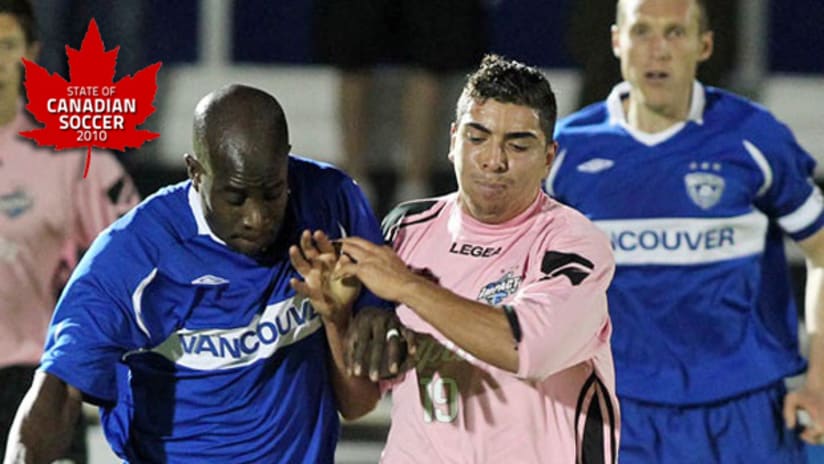Over the next few days — and ahead of the league welcoming its second Canadian franchise, the Vancouver Whitecaps, into the fold — MLSsoccer.com will explore the state of Canadian soccer — where it's been, where it's at and where it's going. On Wednesday, Vancouver Whitecaps president Bob Lenarduzzi suggested MLS' academy systems will benefit Canadian soccer. Here, Whitecaps beat writer Brandon Timko looks at the past — and future — of domestic soccer in Canada.
In 1986 Dionne Warwick was topping the charts with her hit single “That’s What Friends Are For,” Tom Cruise was starring in “Top Gun” and the Canadian men’s national soccer team was in Mexico participating in the FIFA World Cup.
Much has changed since then.
Twenty-four years later and Warwick is now a United Nations Global Ambassador, Cruise is a scientologist and the Canadian men are constant underachievers on soccer’s world stage.
[inlinenode:323331]After what appeared to be a breakthrough in the ‘80s, the Canadians have yet to return to the World Cup. On the other hand, the US national has been to every tournament since missing out in ‘86, a reverse of fortune that makes Canada’s underwhelming performance all the more frustrating.
The 1986 World Cup was supposed to be the beginning, the birth of a true soccer nation, but the inability to maintain high level professional soccer has kept that dream in neutral.
NASL Gone, But Not Forgotten
Canada qualified for the ’86 World Cup as a relatively untapped soccer nation. They made it to Mexico despite not having a domestic professional league, and in fact, with the demise of the North American Soccer League (NASL) in 1984, there wasn’t a single high-level professional soccer team in the country at the time.
That said, their ability to qualify no doubt stemmed from the experience that players on the roster were able to gain while playing in the NASL. With teams throughout the country, including the Vancouver Whitecaps, the Toronto Metro-Croatia, the Toronto Blizzard and the Montreal Manic, the NASL gave Canada’s soccer stars a chance to play among some of the world’s top players, including the likes of Pele and Franz Beckenbauer.
[inlinenode:308073]“The legacy of the NASL was very prominent in the 86’ team,” said Bob Lenarduzzi, a defender on that World Cup squad and currently the Vancouver Whitecaps' president. “The majority of the players in that team played with and against very good players in the NASL, and that was a significant reason why we qualified.”
The Canadian Soccer League Days
Following the World Cup, a domestic league was finally formed to capitalize on the momentum that the national team generated. Eight teams from six provinces across the country took the field to form the Canadian Soccer League (CSL), in which players could stay home and get their shot rather than having to fight tooth and nail to get an opportunity overseas.
Unfortunately, financial difficulties signaled the end of the CSL after only six seasons of play and Canada was unable to build on their international success. The national team bowed out of the opening round of qualification for the 1990 World Cup and then fell agonizingly short of qualifying for the 1994 World Cup, which was held across the border, when they lost to Australia in a penalty shootout in a CONCACAF-OFC Intercontinental Playoff.
“The CSL helped; it provided guys like Alex Bunbury and Paul Peschisolido a vehicle to play and move on to a higher level in Europe,” said Lenarduzzi, who coached the national team during the 1994 campaign. “But there was never a real good business case for it.”
[inline_node:324964]MLS: A Hope For The Future
While Canada has gone more than two decades since their last World Cup appearance, they need only look at their American counterparts for a reason to believe that things can be turned around.
The Stars and Stripes went over thirty years without making it to a World Cup, from 1954 until 1990, but now they are regular participants, and perhaps even challengers for soccer’s Holy Grail.
GALLERY: Canadian MLSers throughout the years
Much of Canada’s hope for the future depends on Major League Soccer. While it may not be a domestic league in the strict sense, Canadian clubs have finally found a stable professional soccer league to play in.
Toronto FC, Vancouver Whitecaps FC and the Montreal Impact (slated to join MLS in 2012) will now hopefully provide a solid base, a place for Canadian players to develop and a jolt of enthusiasm for soccer fans across the country.
“There’s no question that TFC’s success has resulted in other markets being able to benefit,” Lenarduzzi said.
“With the crowds that they’ve generated, the sponsorships, and the interest of the game in Toronto, there’s been a domino effect and ideally we will do well and that will provide Montreal with two examples of what’s happening with the game in this country. Hopefully it will encourage people to think that the game is on an upward spiral.”
Think you know the game? Test your powers of prediction with MLSsoccer.com's fantasy game,Pro Soccer Picks. Play NOW!













